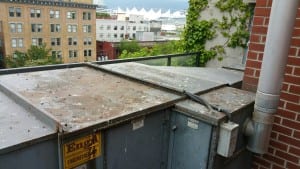 Commonly seen defacing the structures that facility managers (fms) work so hard to build and maintain, pest birds can cause serious problems. From office buildings to schools and hospitals to food manufacturing facilities and restaurants, birds and their droppings create unsanitary conditions and add expense to facility maintenance.
Commonly seen defacing the structures that facility managers (fms) work so hard to build and maintain, pest birds can cause serious problems. From office buildings to schools and hospitals to food manufacturing facilities and restaurants, birds and their droppings create unsanitary conditions and add expense to facility maintenance.
Birds frequent areas because of two primary reasons: shelter and food. In all situations, cleaning existing bird mess away is essential, including droppings, feathers, nests, and any other territorial markings. This task requires proper safety precautions such as wearing protective equipment, as bird mess notoriously carries toxic fungus and transmissible diseases.
No matter what repellent measures are taken, the area must first be thoroughly cleansed of bird smell and visual markings for an approach to be effective. Using a strong cleaner is highly recommended. Certain species are protected under the United States Migratory Bird Treaty Act of 1918, so fms should be certain these laws are understood prior to clearing away any nests to avoid any unexpected fines.
Food sources also must be removed or blocked off. Dumpsters containing organic waste must be secured with lids, and any workers or customers feeding the birds should be instructed to stop. Posting “Do Not Feed the Birds” signs is beneficial for this purpose. Birds are far more difficult to control if food is available to them.
Fms in urban populations are all too familiar with pigeons perching on the sides of buildings and defacing architecture, windows, and sidewalks with droppings. Not only is this aesthetically alarming but large quantities of bird droppings can cause slipping hazards and disease risks—certainly no liability any responsible business takes lightly. In these situations, simple physical barriers are easy to implement—installing bird spikes, bird wire, sticky bird gels, or electrified, low-profile bird track will quickly clear ledges of these pests.
The same methods may be used on the ledges of hospitals, restaurant windows, and schools, as they are humane to pest animals, do not make noise, and do not contain chemicals or poisons.
Fms in food processing facilities know the challenge of birds very well. These situations are even more difficult because not only is there a food source to attract birds, but the FDA and other health organizations have rigid regulations about pest animals and food production. A bird infestation during a health inspection can mean fines, citations, and even business closure.
Pest droppings are obviously unsanitary and can quickly contaminate an area through air conditioning and ventilation ducts or being brought in on workers’ shoes. If birds come in direct contact with the food or processing equipment, finished food products may contain pathogens and feces.
The best success strategy for any food processing plant is to block the food source from pests physically. Securing dumpsters with lids and closing off openings to warehouses and silos will help drastically. If areas are kept semi-enclosed, securing openings with bird netting will not only keep birds out, but will also deter bats, rats, mice, and other pests. In facilities that contain restaurants, bird netting can form an attractive enclosure for patios and open windows.
In semi-enclosed areas such as parking garages, airplane hangars and open warehouses, ultrasonic bird repellent systems are extremely effective with the added benefit of being silent to humans. Ultrasonic soundwaves are above the average human’s hearing range, however the frequencies are disruptive to birds and other pests. Light deterrents such as strobes and laser systems work well in dim warehouse corners, or when pest control is only needed at night.
Large, open outdoor areas such as golf courses with bodies of water, orchards, vineyards, and small lakes can be frustrating for fms due to their attraction for birds, especially when food is available. Taste aversion liquids and physical barriers may not be feasible in these areas, so sonic bird control methods can come into play. Additionally, one of the most effective bird control methods for preventing bird strikes at airports is a sonic control system.The overhangs of all man-made structures, including buildings, overpasses, garages, warehouses, stables, and barns are often prone to problems with barn swallows. These birds exclusively build their mud nests on man-made structures when caves are not available. These birds are protected by federal law (inhabited nests may not be disrupted), so repelling them humanely before nests are occupied is essential. Their nests can cause structural damage, mite infestations, and unsanitary conditions, as well as obvious aesthetic problems. Applying deterrent liquids along the upper walls and eaves of structures, and in certain situations installing physical barriers such as netting, are effective and legal methods to control swallows.
Every facility and bird scenario is different, but no matter the situation or budget an effective solution is available. Avoiding the costs of constant cleaning and maintenance, equipment and property damage, and liability risks make bird control an important part of responsible facility management.
About Pigeon Patrol:
Pigeon Patrol Products & Services is the leading manufacturer and distributor of bird deterrent (control) products in Canada. Pigeon Patrol products have solved pest bird problems in industrial, commercial, and residential settings since 2000, by using safe and humane bird deterrents with only bird and animal friendly solutions. At Pigeon Patrol, we manufacture and offer a variety of bird deterrents, ranging from Ultra-flex Bird Spikes with UV protection, Bird Netting, 4-S Gel and the best Ultrasonic and audible sound devices on the market today.
Voted Best Canadian wholesaler for Bird Deterrent products four years in a row.
Contact Info: 1- 877– 4– NO-BIRD (www.pigeonpatrol.ca)

